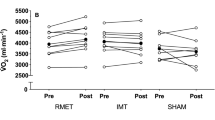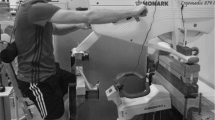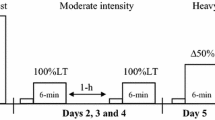Summary
There has been a controversy over whether the increases in maximal oxygen uptake (\(\dot V\)O2 max) and reductions in heart rate at a given submaximal workload after endurance training are limited to exercise with trained limbs or also may be observed during exercise with untrained limbs. In the present study five initially very sedentary young men trained by leg cycling (LT) and five by arm cranking (AT) 30 min per day on 4 days a week for 11 weeks at an intensity ≥75–80% \(\dot V\)O2 max. Before and after training the subjects performed submaximal and maximal arm cranking and leg cycling tests. Leg cycling and arm cranking \(\dot V\)O2 max increased 15% and 9% after LT and 12% and 35% after AT, respectively. Heart rate at a given submaximal workload was lower (p<0.05) during trained and untrained limb exercise following LT and AT. However, subjective ratings of perceived exertion (RPE) at a given submaximal workload were lower (p<0.01) only during exercise with trained limbs after LT and AT. In light of previous findings, the present increases in \(\dot V\)O2 max and reductions in submaximal exercise heart rate with untrained limbs suggest that the initial fitness of the subjects as well as the intensity, frequency, and duration of training may be important factors in determining the extent to which transfer effects of endurance training can be observed. Although the present data suggest that reductions in RPE after endurance training may be the result of local changes in trained muscles, the possible contribution of central nervous adaptations cannot be excluded.
Similar content being viewed by others
References
Allen TE, Byrd RJ, Smith DP (1978) Hemodynamic consequences of circuit weight training. Res Quart 47: 299–306
Bergh U, Kanstrup I-L, Ekblom B (1976) Maximal oxygen uptake during exercise with various combinations of arm or leg work. J Appl. Physiol 41: 191–196
Borg G (1973) Perceived exertion: A note on “history” and methods. Med Sci Sports 5: 90–93
Clausen JP (1976) Circulatory adjustments to dynamic exercise and effect of physical training in normal subjects and patients with coronary artery disease. Prog Cardiovasc Dis 18: 459–495
Clausen JP, Klausen K, Rasmussen B, Trap-Jensen J (1973) Central and peripheral circulatory changes after training of the arms or the legs. Am J Physiol 225: 675–682
Clausen JP, Trap-Jensen J, Lassen NA (1970) The effects of training on the heart rate during arm and leg exercise. Scand J Clin Lab Invest 26: 295–301
Cunningham DA, Hill JS (1975) Effect of training on cardiovascular response to exercise in women. J Appl Physiol 39: 891–895
Daniels J (1971) Portable respiratory gas collection equipment. J Appl Physiol 31: 164–167
Davies CTM, Sargeant AJ (1975) Effects of training on the physiological responses to one- and two-leg work. J Appl Physiol 38: 377–381
Davis JA, Vodak P, Wilmore JH, Vodak J, Kurtz P (1976) Anaerobic threshold and maximal aerobic power for three modes of exercise. J Appl Physiol 41: 544–550
DeBusk RF, Valdez R, Houston N, Haskell W (1978) Cardiovascular responses to dynamic and static effort soon after myocardial infarction. Application to occupational work assessment. Circulation 58: 368–375
Ekblom B, Goldbarg AN (1971) The influence of physical training and other factors on the subjective rating of perceived exertion. Acta Physiol Scand 83: 399–406
Karlsson J, Nordesjo L-O, Jorfeldt L, Saltin B (1972) Muscle lactate, ATP and CP levels during exercise after physical training in man. J Appl Physiol 33: 199–203
Kilbom A, Astrand I (1971) Physical training with submaximal intensities in women. II. Effect on cardiac outpout. Scand J Clin Lab Invest 28: 163–175
Klausen K, Rasmussen B, Clausen JP, Trap-Jensen J (1972) Blood lactate from exercising extremities before and after arm or leg training. Am J Physiol 227: 67–72
Magel JR, McArdle WD, Toner M, Delio DJ (1978) Metabolic and cardiovascular adjustment to arm training. J Appl Physiol Respirat Environ Ex Physiol 45: 75–79
McKenzie DC, Fox EL, Cohen K (1978) Specificity of metabolic and circulatory responses to arm or leg interval training. Eur J Appl Physiol 39: 241–248
Milner-Brown HS, Stein RB, Lee RG (1975) Synchronization of human motor units: possible roles of exercise and supraspinal reflexes. Electroencephalogr Clin Neurophysiol 38: 245–254
Mueller EA (1965) Physiological methods of increasing human physical work capacity. Ergonomics 8: 409–424
Nagle FJ, Irwin LW (1970) Effects of two systems of weight training on circulorespiratory endurance and related physiological factors. Res Quart 31: 607–615
Pandolf KB (1978) Influence of local and central factors in dominating rated perceived exertion during physical work. Percept Mot Skills 46: 683–698
Patton JF, Morgan WP, Vogel JA (1977) Perceived exertion of absolute work during a military physical training program. Eur J Appl Physiol 36: 107–114
Pollock ML, Miller HS, Linnerud AC, Laughridge E, Coleman E, Alexander E (1974) Arm pedaling as an endurance training regimen for the disabled. Arch Phys Med Rehab 55: 418–424
Ridge BR, Pyke FS, Roberts AD (1976) Responses to kayak ergometer performance after kayak and bicycle ergometer training. Med Sci Sports 8: 18–22
Saltin B, Henriksson J, Nygaard E, Andersen P, Jansson E (1977) Fiber types and metabolic potentials of skeletal muscles in sedentary man and endurance runners. Ann NY Acad Sci 301: 3–29
Saltin B, Nazar K, Costill DL, Stein E, Jansson E, Essen B, Gollnick PD (1976) The nature of the training response, peripheral and central adaptations to one-legged exercise. Acta Physiol Scand 96: 289–305
Skinner JS, Hutsler R, Bergsteinova V, Buskirk ER (1973) The validity and reliability of a rating scale of perceived exertion. Med Sci Sports 5: 94–96
Stamford BA (1976) Validity and reliability of subjective ratings of perceived exertion during work. Ergonomics 19: 53–60
Stamford BA, Cuddihee RW, Moffatt RJ, Rowland R (1978) Task specific changes in maximal oxygen uptake resulting from arm versus leg training. Ergonomics 21: 1–19
Winer BJ (1971) Statistical principles in experimental design, 2nd ed. McGraw Hill, New York, pp 752–812
Author information
Authors and Affiliations
Additional information
Supported in part by Grant HL 18907 from The National Heart, Lung, and Blood Institute
Rights and permissions
About this article
Cite this article
Lewis, S., Thompson, P., Areskog, N.H. et al. Transfer effects of endurance training to exercise with untrained limbs. Europ. J. Appl. Physiol. 44, 25–34 (1980). https://doi.org/10.1007/BF00421760
Accepted:
Issue Date:
DOI: https://doi.org/10.1007/BF00421760




